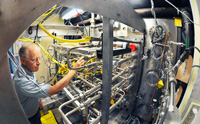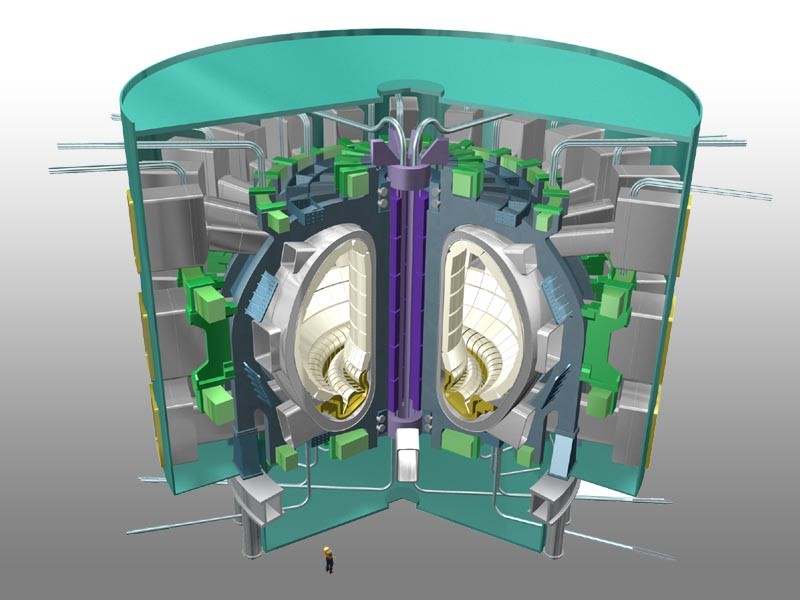NEWS RELEASES
FOR IMMEDIATE RELEASE
September 29, 2008
Forward wall to enclose small star on Earth passes Sandia tests
Tiles to surround 100-million-kelvin plasma at ITER fusion machine

Sandia researcher Jim McDonald checks calorimetry diagnostics for ITER's cooling system. The system supports the front-wall tiles qualified by Sandia as fit for installation in the $14 billion fusion machine under construction in Cadarache, France. (Photo by Randy Montoya) Download 300dpi 8MB JPEG image (Media are welcome to download/publish this image with related news stories.)
ALBUQUERQUE, N.M. —Two prototype systems expected to help contain plasma exceeding 100 million kelvin have been qualified as fit-for-use by Sandia researchers. The systems, each fronted by tiles with a heat absorption system behind them, are from the US and the European Union.
The plasma will be housed at the $14 billion International Thermonuclear Experimental Reactor (now known solely by its acronym ITER) in southern France. The 10-story-high machine — the world’s first burning plasma device — is intended to show that electrical energy can be harvested essentially from sea water, the most widespread material on Earth.
ITER also happens to be a Latin word that means “the path” or “the way.”
ITER, expected online in 2019, will provide a different path to nuclear fusion from the nanosecond, megagauss compression of tiny capsules of hydrogen isotopes at Sandia’s Z machine.
Instead, ITER’s task will be to show that stable magnetic fields in the 50 to 130 kilogauss range — generated by the most powerful magnet of its type on Earth, twice as powerful as CERN’s — can contain a heated plasma of deuterium and tritium for a long time in a large volume. That would be six times hotter than the sun’s 15 million K core, for roughly 15 minutes, in a containment device called a torus that resembles an elliptical donut with a major axis of 6.2 meters and a volume of 500 cubic meters.
The systems tested by Sandians have a dual purpose.
Their tiles will form the first line of defense for ITER’s nuclear shield modules that protect the magnets and vacuum vessel from neutron damage.
The systems also absorb plasma ions, energetic neutral atoms, and X-rays while minimizing the amount of contamination reentering the plasma. The energy absorbed is transmitted through a mostly copper support structure to pipes containing a water coolant.
In a power plant, helium coolant would spin turbines to generate electricity.

An artist's conception of the 10-story ITER reactor. The D-shaped unit represents the torus that will house the 100 million K plasma. The little man, bottom left, is 2 meters (roughly 6 ft.) tall. Download 300dpi 600KB JPEG image (Media are welcome to download/publish this image with related news stories.)
To test the response of the system and its ability to withstand heat fatigue, Sandia researchers rastered an electron beam over the mostly beryllium tile surface. Infrared cameras observed heat distribution and whether any tiles came loose from their heat-sink backing.
The system endured more than 140 watts of energy deposited on each square centimeter of tiles — the equivalent of 1.4 megawatt over a square meter.
“These are not solar panels,” says Sandia researcher Dennis Youchison of the test output heat intensity. “This is nuclear fusion. This will be a small star on Earth.”
There will be 468 of the tile-fronted systems, one for each nuclear (basically, neutron) shield module in ITER. Eighteen minor variations in module size are required to completely cover the complex torus surface of 500 square meters.
Each one-meter system will be covered by about 800 50-millimeter-square tiles.
To the plasma, “It will look like a fully tiled wall in an ancient Roman bath,” says Youchison.
The tiles will be supported by a copper backing strengthened by the addition of chrome and zirconium. The metal support, almost as strong as steel, will have four times steel’s thermal conductivity, important in removing heat absorbed by the tiles through the metal support structure. By design, the tile temperature will vary between 100 and 340 degrees C, setting a new standard for heat sinks with a nuclear plasma flux.
The US tiles are mortared to their heat sink by thin layers of titanium and copper, diffused together at high temperatures.
“The toughness and stability of the joining layer is the heart of the technology developed by Sandia for the US tiles,” says physicist and Sandia project lead Mike Ulrickson. “This is the first time anyone has created a heat sink that can handle this intense an environment.”
Only Sandia and the European Union lab BESTH in the Czech Republic are approved by the ITER international organization to test the prototype systems, pairs of which will be made in Russia, China, Korean, and Japan, in addition to the EU and US.
The Czech lab uses a radiative, ohmic heater.
“Because of our e-beams, we can see the entire surface during testing,” says Youchison. “Tiles in the Czech lab are covered up with their heater. They can run unattended, but they could have a tile melt and not know it.”
Sandia has a unique capability in engineering, testing, design, and process development. Roughly 20 people at Sandia do thermal hydraulic analysis, electromagnetic calculations, stress analysis, materials and joining, applied physics, and plasma wall interactions to support the final design for ITER.
In ITER’s later stages, the 0.5-meter-thick steel nuclear shield is expected to be replaced with a lithium “blanket” equally thick that will make lemonade out of lemons, so to speak, from the dangerous neutrons — almost all of which will penetrate beyond the tile wall. Instead of merely absorbing the neutrons, as will the steel shield, lithium will utilize neutrons to breed tritium gas, which can then be pumped back into the plasma for fusion purposes.
Initially, ITER’s tritium will be imported rather than produced internally by the machine.
Sandia is a multiprogram laboratory operated by Sandia Corporation, a Lockheed Martin company, for the U.S. Department of Energy’s National Nuclear Security Administration. With main facilities in Albuquerque, N.M., and Livermore, Calif., Sandia has major R&D responsibilities in national security, energy and environmental technologies, and economic competitiveness.
Sandia news media contact: Neal Singer, nsinger@sandia.gov
(505) 845-7078